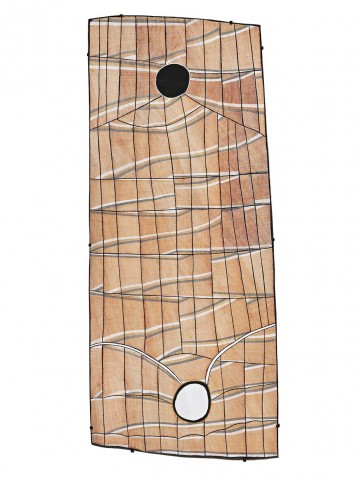BILLABONG AT MILMILNGKAN, 2008
JOHN MAWURNDJUL
natural earth pigments on eucalyptus bark
182.0 x 76.0 cm (irregular)
Maningrida Arts and Culture, Maningrida, Northern Territory (label attached verso, cat. 1432-08)
Private collection, Queensland, acquired from the above in 2008
Milmilngkan, 2008, natural earth pigments on eucalyptus bark, 171.0 x 71.0 cm, in the collection of the Art Gallery of South Australia, Adelaide
This painting is accompanied by a certificate of authenticity from Maningrida Arts and Culture, Maningrida.
‘Milmilngkan is a duwa moiety place belonging to us. This is the place where I live. There is a sacred site, a Djang, near the billabong … Milmilngkan is where the Rainbow Serpent pierced the ground. There is a Rainbow Serpent there that watches over us’.1
Situated sixty kilometres south of Maningrida in central Arnhem Land, Milmilngkan is a spring not far from a billabong where John Mawurndjul has a seasonal camp. As disclosed in the accompanying certificate, Milmilngkan is a site of immense significance within the structures and dynamics of Kuninjku culture, for ‘underneath the waters of Milmilngkan lies the power of Ngalyod the Rainbow serpent’.2 A familiar subject of contemporary Kuninjku bark paintings, Ngalyod is the protector of all sacred sites and its power is present in each one. Ngalyod has both powers of creation and destruction and is most strongly associated with rain, monsoon seasons and rainbows which are a manifestation of its power and presence. Associated with the destructive power of the storms and with the plenty of the wet season, Ngalyod is a destroyer and a giver of life whose power controls the fertility of the country and the seasons.3
Guided by his father Anchor Kulunba, elder brother Jimmy Njiminjuma and his uncle Peter Marralwanga, Mawurndjul received a very traditional upbringing that resulted in his extensive knowledge of ritual ceremony and strong interest in cultural heritage. At a young age Mawurndjul was recognised as an exceptional painter of body designs for ceremony. As the artist recalls, ‘I saw my father doing the rarrk (cross hatching) for the Mardayin ceremony and tried to do it myself with my back all doubled over, I ended up being better than any of them at it. They gave me a job in the Mardayin ceremony to paint some rarrk’.4
Originally painting figures and creatures in Kuninjku mythology, he has over the years developed a more metaphysical representation of specific sites, events and landscape. Constantly striving for new ways to interpret his country, Mawurndjul’s innovative use of rarrk to map important locations is evident in the fine lineal clan designs spread across the surface of his paintings, creating shifting patterns of grids that are rendered in fine interlocking lines. His paintings pioneered a new interpretation of clan sites and djang that inspired the next generation of bark painters and his influence can be seen in the work of his younger brother James Iyuna, and other artists such as Ivan Namirrikki, Samuel Namundja and Owen Yalandja.
1. The artist quoted in John Mawurndjul, I am the Old and the New, Museum of Contemporary Art, Sydney, 2018, p. 181
2. Taken from the accompanying certificate of authenticity from Maningrida Arts and Culture
3. ibid.
4. rarrk: John Mawurndjul, Journey Through Time in Northern Australia, Museum Tinguely, Basel, 2005, p. 43
CRISPIN GUTTERIDGE
